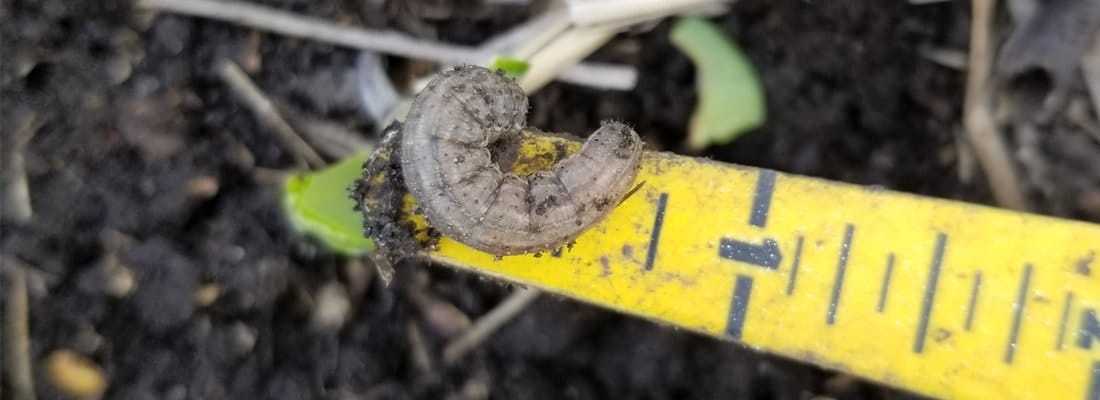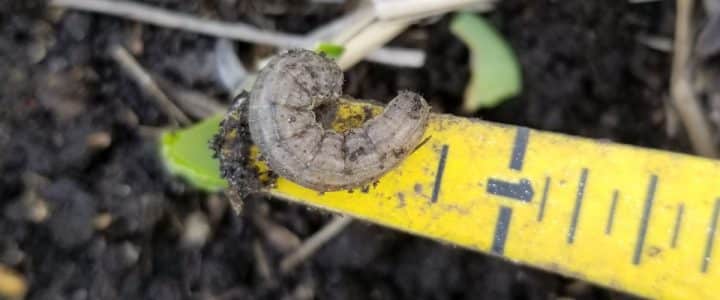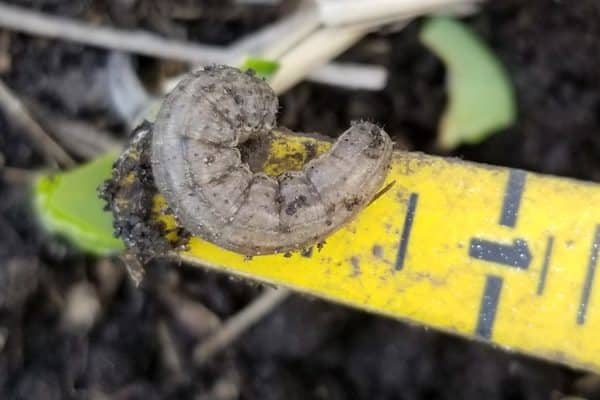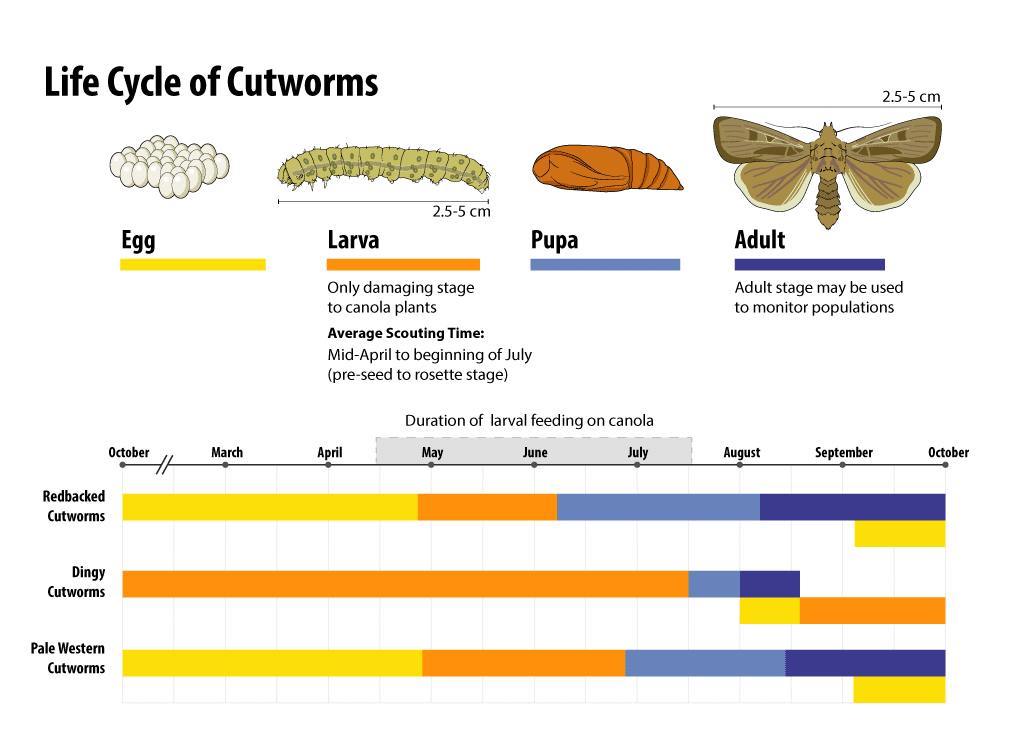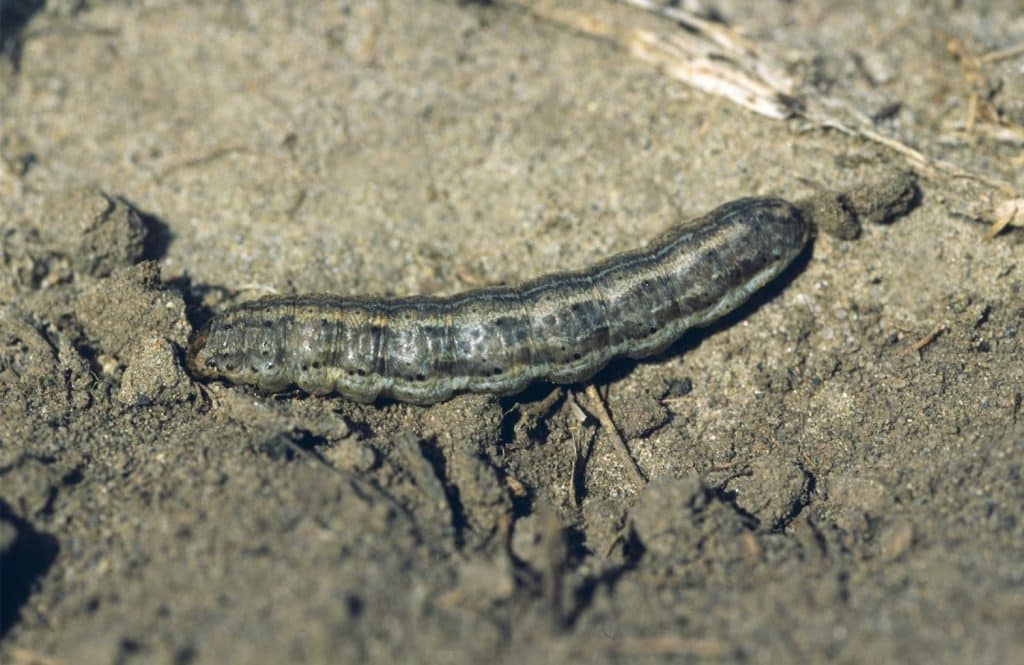The larval stage of various cutworm species (including redbacked, pale western, darksided and dingy), can cause damage to canola plants by feeding on the cotyledons, leaves, stems or under soil surfaces. Scouting, accurate diagnosis of damage and cutworms, recommended nominal thresholds and knowledge of the insect are imperative to good management of these common insect pests. Field management and insecticide options provide control options for this generalist, if needed.
Important tips for best management
- The key to minimizing damage is early detection. Scout the fields and inspect seedlings every three to four days during the first few weeks of crop development, looking for bare areas, holes or notches in foliage, and plants that are wilting, toppling over or completely cut off. Warmer, south facing slopes may show damage first.
- Small larvae 12 to 18 millimetres (0.5 to 0.7 of an inch) pose the greatest potential for damage as they will still feed and grow.
- Knowing the species of cutworm can be important because some species complete the larval stages earlier in the year than others, and some species are more likely to feed on and clip stems than others.
- After the second or third year of infestation, beneficial organism populations such as parasitic insects, viral diseases and bacterial infections usually build enough to begin bringing cutworm numbers down.
- A nominal economic thresholdAn economic threshold is the level of infestation (ex. pest insect density) at which lost yield (ex. due to feeding/insect pest damage) exceeds the cost of the chemical and its application. More may be reached at 25 to 30 per cent stand reduction.
- Determine if the population is patchy or evenly distributed throughout the field. High populations are often localized, leading to expanding bare patches in fields as they consume all the canola plants in an area and move outward in search of more food. Spot spraying the affected patches and a pass or two in the surrounding crop can often be effective in limiting outbreaks.
Overview of the cutworm
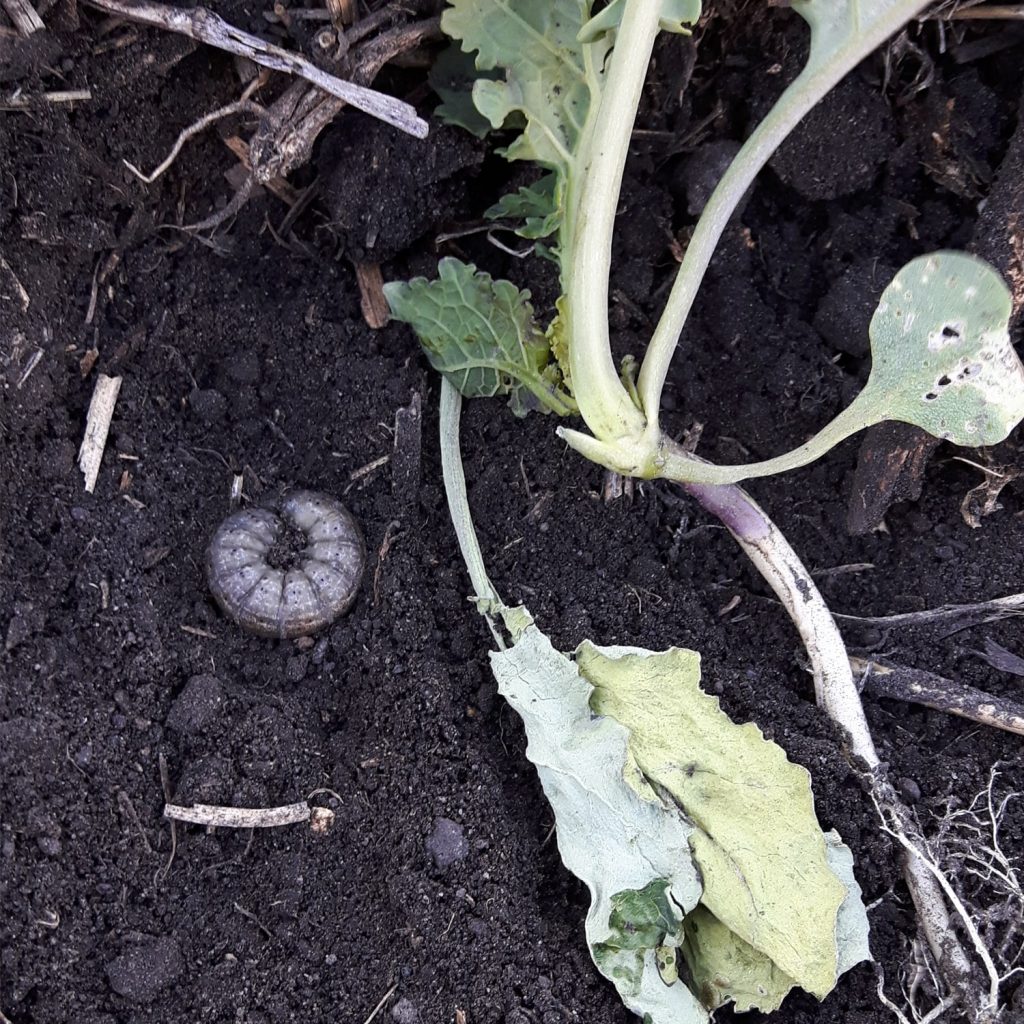
Cutworms can be a significant pest in canola. More than 20 cutworm species may damage Prairie crops, with five economically significant cutworm species described below. Some species are more dominant in certain geographic areas than others, with the potential for more than one species to be present in an infestation. Cutworms are usually present in cropland, but at levels well below economic thresholds. However, cutworm outbreaks seem to be occurring with greater frequency. They were a serious insect pest in canola from 2007 to 2010 and again in 2023.
The pale western and redbacked cutworm continue to be the most common species affecting canola crops, but reports suggest other species are also contributing to this increased frequency of outbreaks. Both cutworm species feed on practically all field crops, vegetables and home garden plants. They are most destructive when feeding on canola, cereals, flax, sugar beets and mustard.
Life cycle of the cutworm
Cutworm species in western Canada produce only one generation per year. Adult cutworm moths may lay several hundred eggs on vegetation or in the soil in August and September. Many cutworm species overwinter as the tiny eggs that are laid in fall. In April or early May, the eggs hatch and the young larvae feed mainly at night on weeds and volunteer plants until host crops begin to emerge. Army cutworm eggs hatch in August and the larvae feed until freezing temperatures occur, when they overwinter as larvae. Dingy cutworm also overwinters as larvae.
The young larvae of most species pass through six stages (instars), each separated by a shedding of skin (molting). Late May and the first three weeks in June are the most likely times for cutworm activity (seedling to rosette stage). The larger cutworms are usually easy to find in the soil near damaged or freshly cut plants. Younger larvae may require more careful searching. When disturbed, the cutworms will curl up in tight “C” shape. This is characteristic of all cutworms and armyworm species.
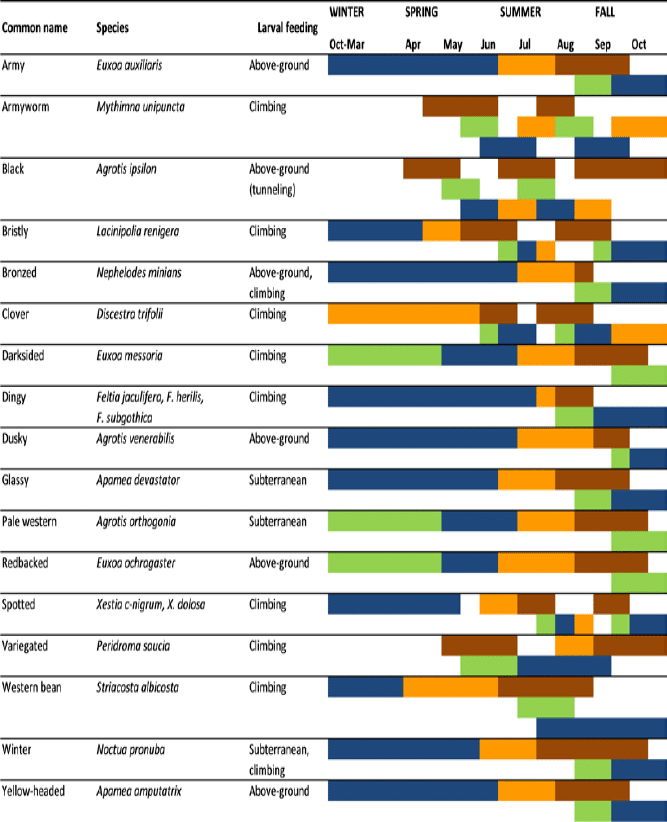
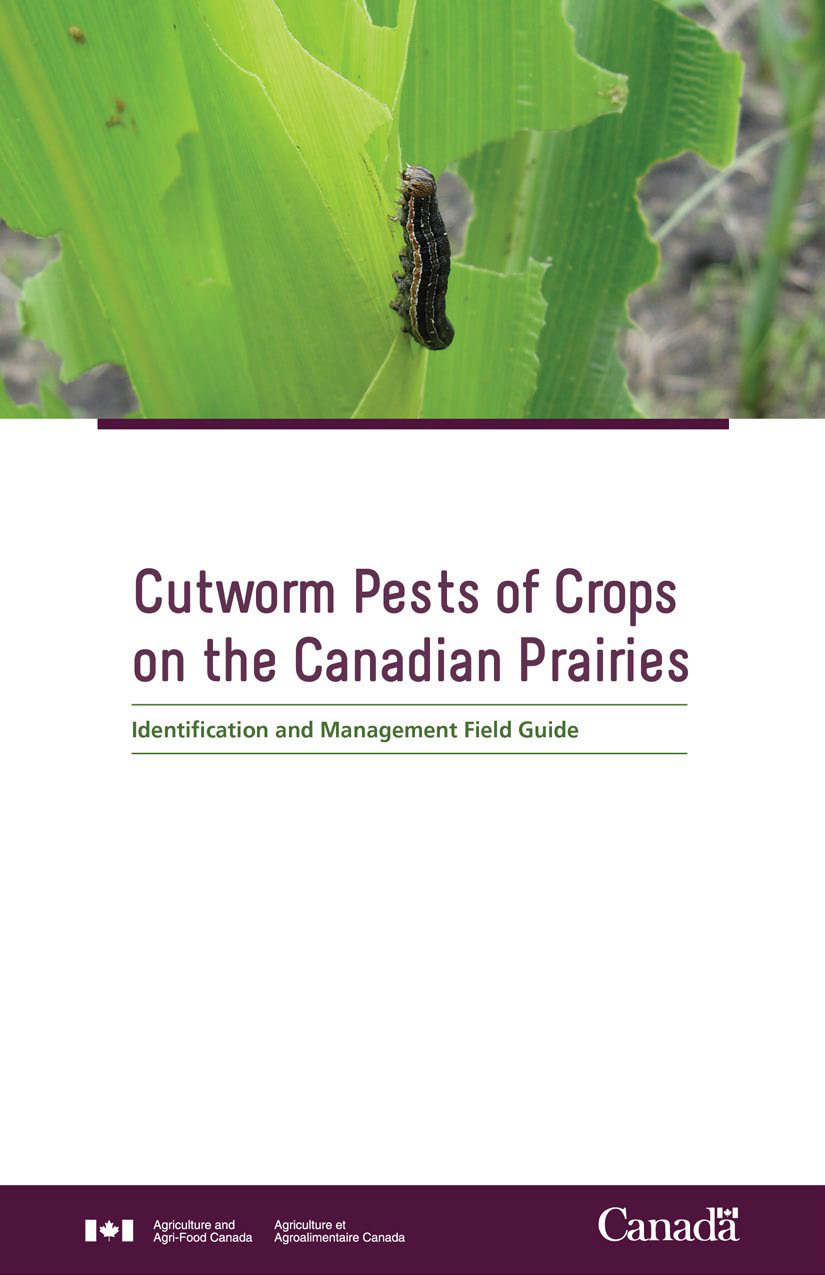
The length of time cutworms spend in their potentially damaging (larvae) stages depends on the species and the temperatures they are exposed to. For example, redbacked cutworms kept at 15 degrees Celsius take 65 days on average to complete their six larval stages, while they completed their larval stages in 29 days when kept at 25 degrees Celsius. However darksided cutworms take an average of 87 days to go through their seven larval stages 1, 2.
At maturity, the larvae range in size from 30 millimetres (1.2 inches) to 38 millimetres (1.5 inches) depending on species.
After the cutworms complete their larval growth, usually in late June, they burrow deeper into the soil where they make a small soil chamber in which to pupate. Almost all (of the pest species of) cutworms form a reddish-brown, torpedo-shaped pupae similar in size and shape.
Following the pupal stage, adult moths emerge from the soil in August to early September. The moths are night fliers and not usually seen. After mating, the moths lay eggs on or just below the surface with some preference for loose, dry soil or weedy areas.
Agriculture and Agri-Food Canada’s Cutworm pests on the Canadian Prairies for the full version of this chart of approximate seasonal occurrence of lifecycle stages for different species of cutworms.
Influence of environment
A hot, dry August provides the best conditions for moth feeding on flowers. Egg production and egg laying depend on the nutrition obtained from flowers. The same weather conditions promote the loose, dry soil surfaces preferred by some species for egg deposition. Warm, dry spring weather can increase the severity of damage from cutworm attack.
Wet or very dry soils during the larval stage impact cutworm behaviour and feeding habits. The larvae of the pale western cutworm, for example, usually remain in the soil unless forced to the surface by rain or hard soil, where they are subject to attack by parasites and predators. Wet soil conditions during the larval stages can promote fungus diseases among cutworms.
Identification of the cutworm
Scouting techniques
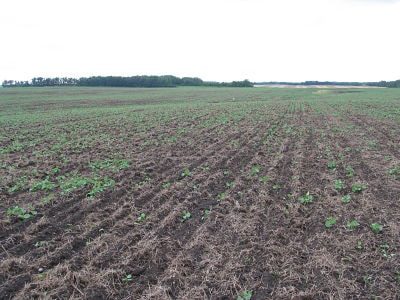
Most cutworm species feed at night and hide during the day, making detection difficult. However, the key to control is early detection, so inspect seedlings every three to four days during the first few weeks of crop development. Look for bare areas, holes and notches in foliage, and plants that are wilting, toppling over or completely cut off. Determine whether bare areas with no seedlings resulted from poor germination or cutworm damage.
Bare spots will begin to appear within the field, typically first on south facing slopes and hilltops where the soils are warmer and soil texture is lighter. Check the edges of bare areas for cut-off plants and search the top five centimetres (two inches) of soil around such plants for larvae. When notched, wilted, dead or cut-off plants (weed or crop seedlings) are seen, dig around the roots of the plants for cutworms.
To collect cutworm larvae, a garden trowel and a soil sifter are useful tools. Cutworms may be found down to about 10 centimetres (four inches) below the soil surface, particularly if the soil is dry and larvae are in their later stages. Larvae often curl up or attempt to hide in the debris when exposed. Cutworms curl into a characteristic “C” shape when disturbed or first held in hand. Pupae may also be collected in this way.
Action threshold
A nominal thresholdNominal thresholds are decision guidelines based on experience rather than research quantifying the impact of the insects on the crop. More of 25 to 30 per cent stand reduction has been suggested. Scout throughout the field to determine the distribution of larvae, as patch spraying is sometimes sufficient to control outbreaks. Check for green material in the gut of larvae to determine if they are actively feeding, as they will cease feeding temporarily during molting between instars. This could affect the ideal timing for control measures depending on the proportion of larvae that are not actively feeding, although residual activity of most registered products should allow for adequate control.
The larvae and pupae can be reared to adult moths if necessary for species determination.
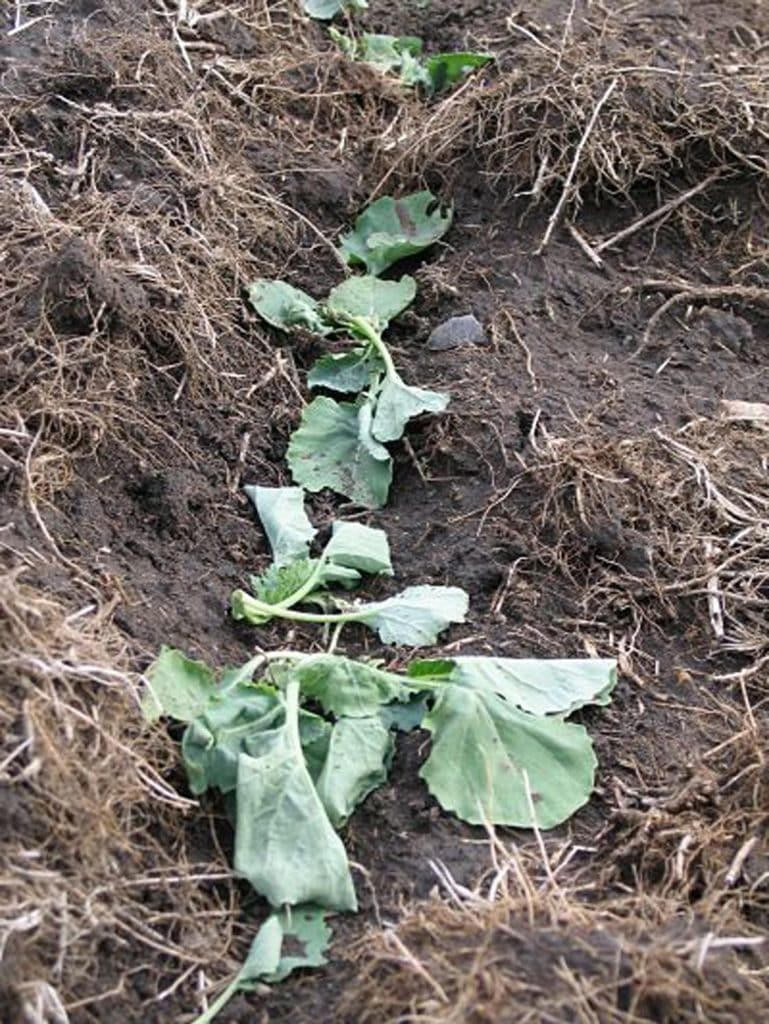
An Ontario study on darksided cutworms found older larvae at a depth of eight to 10 centimetres (three to four inches) from the soil surface. Most younger larvae rested in the soil at six to 13 millimetres (0.25 to 0.5 of an inch) near the base of the host plant 2.
It is important to determine the staging of cutworms when scouting, as some stages of larval development hold more potential for crop damage than others. When larvae are small (12 to 18 millimetres, or 0.5 to 0.7 of an inch) they pose the greatest potential for damage as they still must feed to grow. Once larvae have reached lengths of 30 to 35 millimetres (1.2 to 1.4 inches), most of their feeding has already occurred and chemical intervention may not be warranted.
Like most moths, cutworm moths (adults) are nocturnal and attracted to light, so their (adult) population can be monitored using light traps. Sex attractants also can be used to trap adult cutworm moths in commercial or homemade pheromone traps. Bertha armyworm, a climbing cutworm species, lays its eggs on canola each year and has been successfully monitored in this way. However, these traps have not been found to be a reliable means of predicting the level of cutworms in the next season 3.
Damaging species and stages
Correctly identifying cutworm species is helpful because some species complete the larval stages earlier in the year than others, and some species are more likely to feed on and clip stems than others 4. Redbacked, pale western and army cutworms overwinter as eggs, and their larvae can start feeding in early June. While other species may overwinter as larvae and begin feeding even earlier, making it important to continue scouting canola crops for both potential issues. In the southwest Prairies, the pale western cutworm tends to be the dominant species, whereas in the parkland and northern regions, the redbacked cutworm is of the greatest concern.
The Western Forum on Pest Management indicated that other cutworm species have become more common in Prairie crops in the last number of years. Dingy cutworms have been found in eastern regions and army cutworms have been reported from western regions. Several of these less common species have also been reported in Manitoba. Dingy and army cutworms feed above ground, consuming the plant foliage. Typically, these cutworms are more likely to cause damage on hilltops and in drier areas of a field 5.
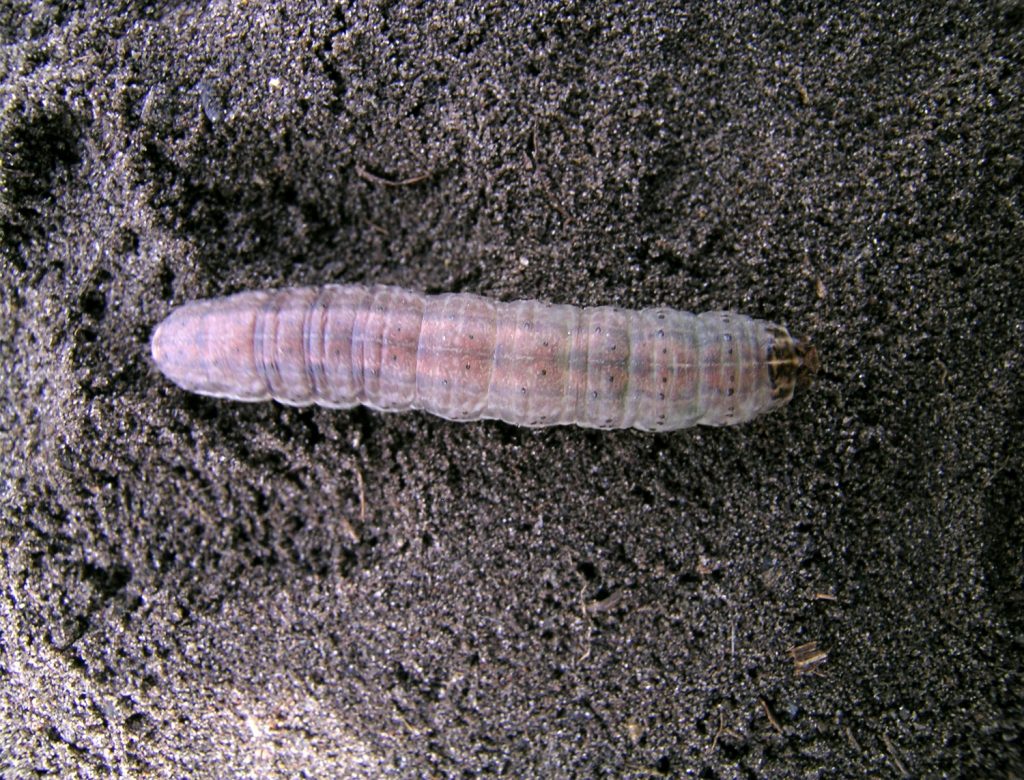
Redbacked (Euxoa Ochrogaster Guen)
Larvae of redbacked cutworms have two broad dull-red stripes along the length of their back. The head is yellowish-brown. Mature larvae are about 38 millimetres (1.5 inches) long. Young redbacked cutworms chew holes and notches in leaves, while older larvae eat into the stems and usually sever them at or just above the soil surface. Cut plants can be found drying up and lying on the soil surface.
Adult moths of the redbacked cutworm have four colour forms and are light fawn to brick red in colour. The flight period for moths of the redbacked cutworm in Manitoba extends from mid-July to October. The peak flight period occurs during August 6.
Host plants include canola, cereals, flax, corn, mustard, sunflower, sugar beet, forage legumes, vegetables amongst others 7.
Pale western (Agrotis Orthogonia Morr.)
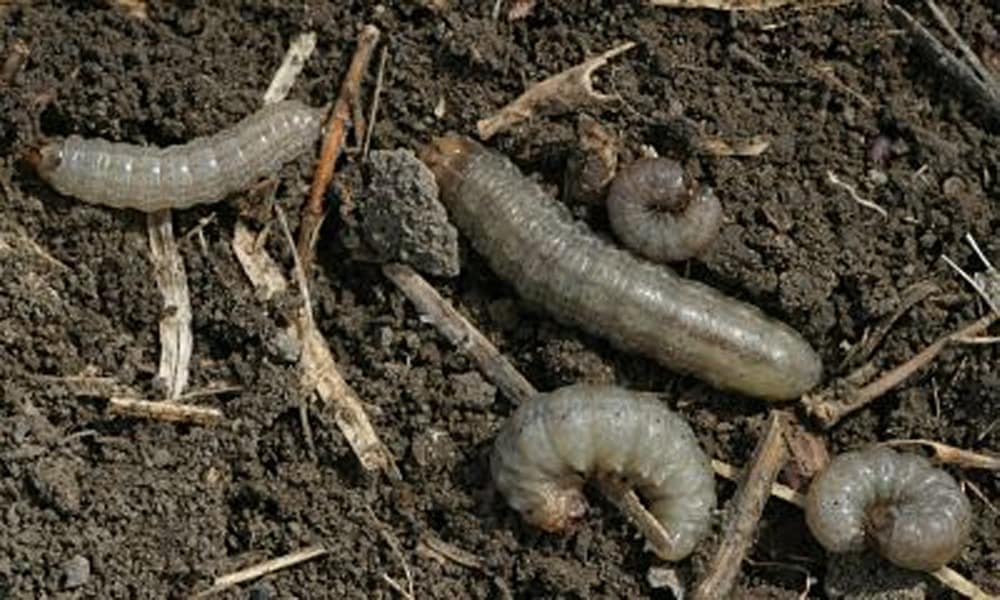
The pale western cutworm is a more serious pest in Saskatchewan and Alberta, with less impact in Manitoba. New larvae are almost colourless and about three millimetres (0.12 of an inch) long. Fully grown larvae vary in length from 30 to 36 millimetres (1.2 to 1.4 inches) long, and are pale gray to greenish gray in colour lacking any stripes or distinguishing marks. The head capsule is usually yellow-brown.
The larvae feed mainly underground, only surfacing when the soil is hard or very wet. The first signs of damage are holes cut into emerging leaves. These holes are cut when the leaves are still underground. Larger larvae move down crop rows, cutting off the plants underground. Feeding damage is similar to redbacked cutworm.
Pale western cutworm moths (adults) are mottled greenish grey with distinct pale lines on the forewings.
Host plants include cereals (preferred), canola, flax, corn, mustard, sugar beet, field peas and other legumes, and selected weeds 7.
Army cutworm (Euxoa auxiliaris)
Army cutworms are more common in the arid regions of the western Prairies, and rarely found at economic levels in Manitoba. The larvae are hairless, pale greenish-grey to brown with a pale-striped back, and finely mottled with white and brown, but without prominent markings. There is usually a narrow, pale mid-dorsal stripe, and the head is light brown (tan) with small dark spots 8.
As an above ground feeding larvae, the army cutworm notch and strip off leaves in a localized area then move as a collective group or “army” when food sources are consumed. Larvae generally feed from late afternoon to early evening, making scouting easier 8. Overwintering as larvae, army cutworms can be particularly damaging to canola when they once again begin feeding in early spring. The adult moth is 40 to 45 millimetres (1.6 to 1.8 inches) and grey-brown with two prominent spots on the forewing 8. The female moths lay about 1000 eggs in soft soil in late August, and the eggs hatch and larvae feed on plant foliage during the fall. Development stops when the ground freezes. The larvae begin to feed again in April, and continue to feed until pupation in May to early June.
Host plants include canola, wheat, oat, triticale, barley, mustard, flax, alfalfa, sweet clover, pea, cabbage, sugar beet, selected weeds with a preference for stinkweed, and grasses 7.
Darksided cutworm (Euxoa messoria)
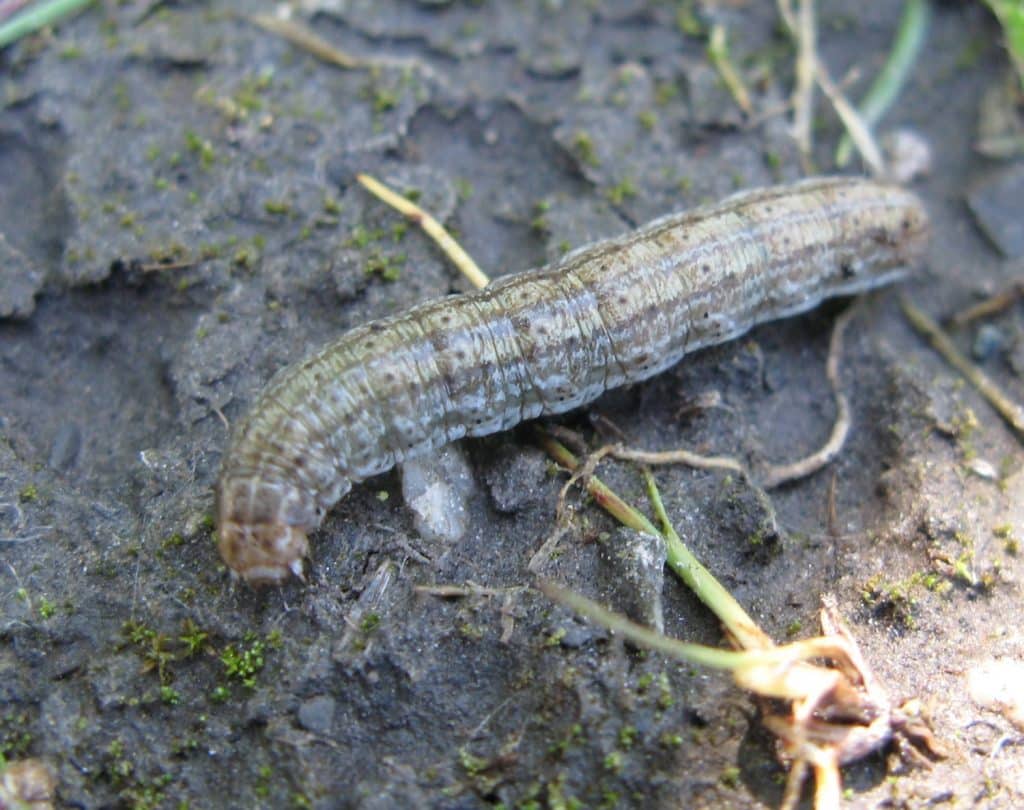
Darksided cutworms are soft, thick-bodied, grayish larvae with shiny heads, at maturity reaching a body length of 37 millimetres (1.5 inches). Each larva has a prominent white stripe on the side above the legs and dark colouring on the head resembling spots or freckles.
During the day the larva remains curled in the soil at the base of the plant on which it feeds at night. The larvae chew emerging plants at or below the soil surface. They may completely consume the above-ground portions of small plants, and especially the succulent ones that have been transplanted recently 7.
Darksided cutworm is often found in mixed populations with redbacked cutworm, and may be easy to confuse 4.
Dingy cutworm (Feltia spp.)
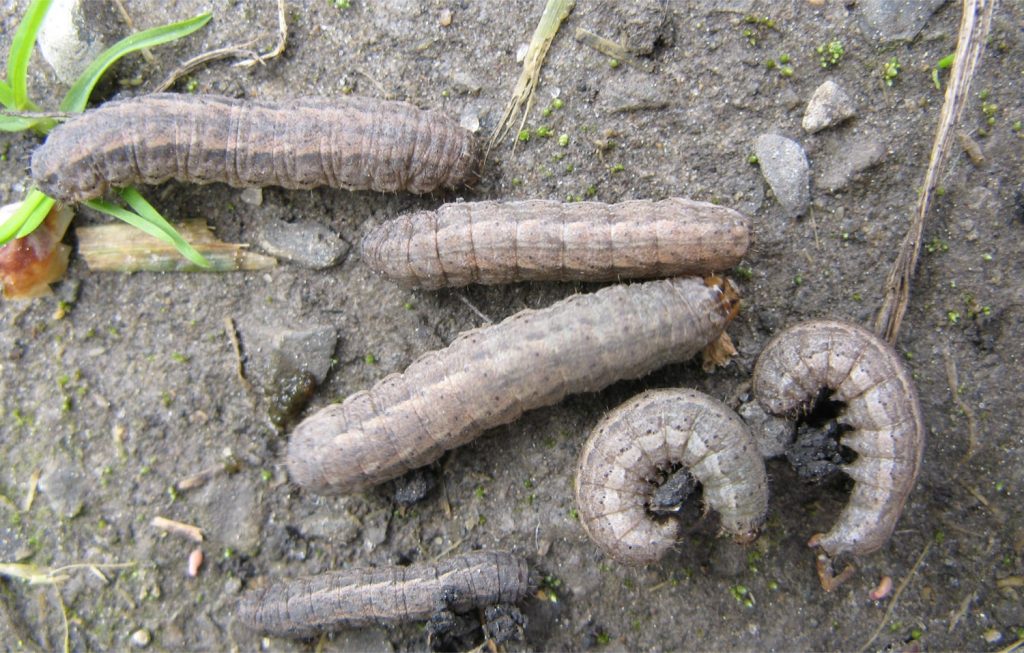
Dingy cutworm is the common name of three different Feltia species that are not practically distinguishable in the field. Larvae of dingy cutworms are hairless grayish brown in colour with a thin light line down the very middle of the back. On either side of this thin line there is a broader series of somewhat diagonal markings that look like tire tracks, or to form “V’s” on the back. They also have four equal-sized black dots on the back surface of each abdominal segment. Dingy cutworms are climbing cutworms, feeding primarily on leaves. Overwintering as larvae, damage is most obvious in early spring as maturing larvae feed aggressively 7.
Additional species
For identification of all Canadian cutworms, see Agriculture and Agri-Food Canada’s Cutworm pests on the Canadian Prairies: Identification and management field guide.
What does cutworm damage look like?
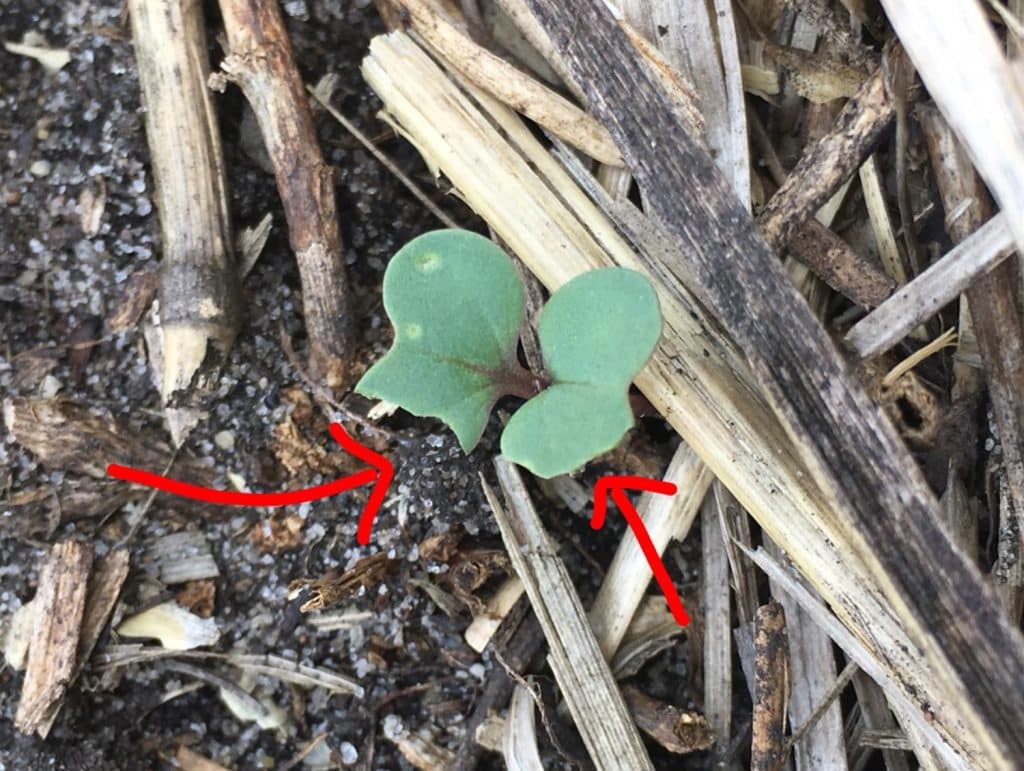
Patches of bare soil characterize infestations where the crop has started to disappear. These patches gradually enlarge until the area of destroyed crop reaches anywhere from 0.5 to one hectare (one to two acres) to the complete field. First signs of damage usually appear on hilltops, south facing slopes or in areas of light soilA soil that is high in sand content. More that normally warms faster and shows damage early. Depending on the cutworm species and the time of year, individual plant damage ranges from entire plants consumed at the cotyledon to the five-leaf stage, leaf notching or removal, to clipped and drying half cotyledons, leaves or whole plants left at the soil surface.
Cutworm damage tends to occur rapidly on individual plants. Plants or leaves clipped and uneaten by cutworms tend to dry a vibrant green and should not be confused with nutrient deficiency, waterlogging or root and stem damage that slowly causes stressed or dead plants to show a reddish or purplish discolouration. Cutworm damage can also be confused with poor stand establishment, particularly on bare hilltops where germination is often assumed to be poorer.
How to manage cutworms
Natural enemies and biological control
Natural enemies to cutworm species may increase as cutworm populations rise. These natural enemies are mainly comprised of parasitic insects, viral diseases and bacterial infections. Typically, after the second or third year of infestation, beneficial organism populations build enough to begin bringing cutworm numbers down. These larger populations of naturally occurring biological controls will usually keep cutworm outbreaks from occurring again for at least a couple of years.
Many predaceous insects, parasites and birds prey upon cutworms and reduce their populations. Flocks of birds following equipment disturbing the soil may be an indication of high cutworm populations. A Saskatchewan study found redbacked cutworms (larvae) parasitized by four species of bee flies, at least four species of tachinid flies, and several species of parasitic wasps. Ground beetles can also be important predators of cutworms. Disease and parasites have been found to be the most important factors causing the rapid decline of redbacked cutworms from the peak of an outbreak 4.
Field management (cultural controls)
Cultural controls are an important part of managing cutworm activity.
Weed control and crop rotation
The presence of a flowering food source for flying adults in fall, or plant material (weeds) that may provide an attractive location for egg laying have been linked to the potential for cutworm issues in this same area the following year. Good weed control practices throughout a crop rotation may limit cutworm infestations, while lack of weed control the previous year may indicate an area for scouting next season.
Growers breaking up forage crops for canola production should be prepared to scout and possibly spray for cutworms.
Seeding date
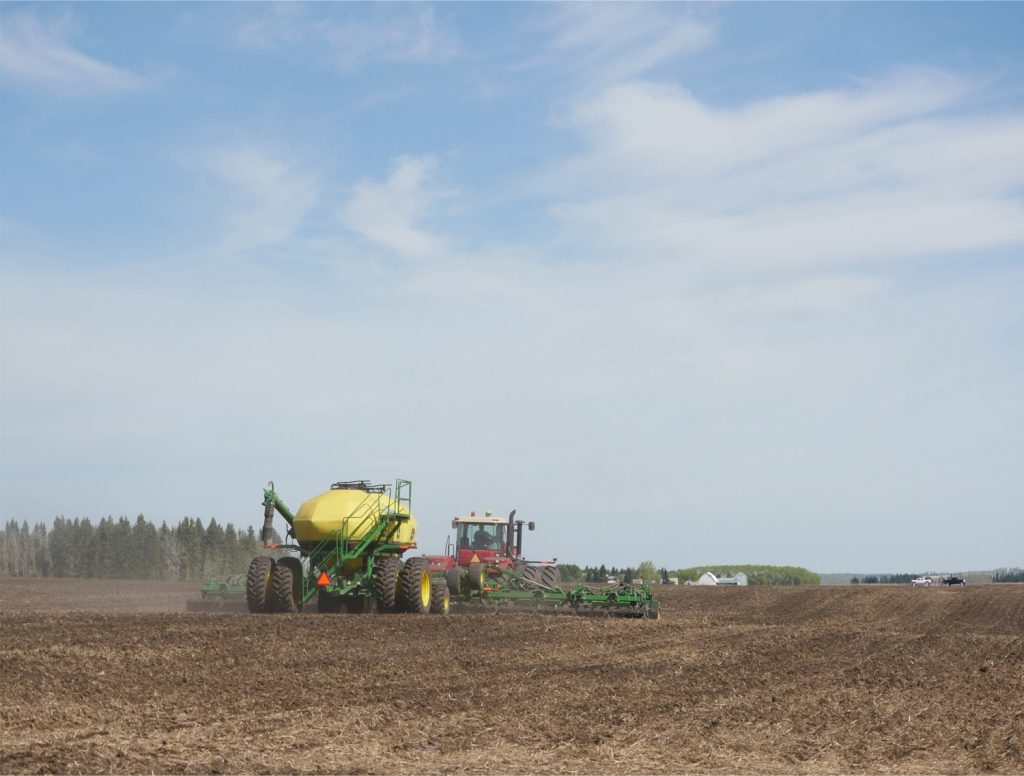
Tillage in the spring can provide effective management in fields known to have high cutworm numbers 4. This will set back the seeding date, but may protect the stand from severe cutworm damage. Allow volunteer growth to reach three to five centimetres (1.2 to 2 inches), then cultivate. Follow with seeding 10 to 14 days later. Studies with pale western cutworm have shown that larvae which have already fed will die if deprived of food for several days. Cold weather after cultivation and seeding will have a similar effect. Growers should weigh the potential for reduced cutworm damage against any negative effects tillage may have on the quality of the seedbed and its moisture status, which may reduce seedling survival. Reduced yield potential from delayed seeding is another consideration, often these negative effects may outweigh the benefits where cutworm populations only occasional reach numbers sufficient to cause significant losses 4.
Reseeding
Growers needing to reseed as a result of significant cutworm damage are advised to seriously consider an insecticide application to ensure the emerging crop doesn’t suffer cutworm damage.
Minimum tillage
An eight-year Manitoban study found that minimum tillage practices were associated with greater diversity of cutworms and their parasitoids, including some non-pest species of cutworms, than fields under conventional tillage. Minimum-tillage was not related to increased crop loss from cutworm, and the study proposed the increased diversity suggests a more stable ecosystem in which outbreaks of cutworms would be less common 9.
Economic threshold
Cutworm control may only be necessary in small areas of the field, when bare patches appear and large numbers of cutworms are still actively feeding. Canola may be more susceptible to cutworm damage than cereals because no regeneration and tillering occurs in canola (as it does with cereals) to compensate for loss of plants, although the ability of canola with minimal damage to produce more yield in thinner stands needs further study.
Action threshold
A nominal thresholdNominal thresholds are decision guidelines based on experience rather than research quantifying the impact of the insects on the crop. More of 25 to 30 per cent stand reduction has been suggested. Additional information for pale western, redbacked and darksided cutworms indicates an economic thresholdAn economic threshold is the level of infestation (ex. pest insect density) at which lost yield (ex. due to feeding/insect pest damage) exceeds the cost of the chemical and its application. More of four to six larvae per square metremay warrant control 7.
The nominal thresholds is based on experience rather than research quantifying the impact of the insects on the crop, as little research has been done to develop economic thresholds in field crops.
Insecticide control options
Seed treatments
Cutworm seed treatment control options in canola which include the active ingredient cyantraniliprole (currently marketed as Fortenza and Lumiderm) have shown excellent performance on cutworms. The length of protection will depend on the rate used, insect pressure, crop stage as well as soil and environmental conditions. Higher rates should be used when insect pressure is expected to be high. These seed treatment options are typically available as a special order at additional cost, with their purchase made long before cutworm pressure can be accurately predicted 10.
Foliar insecticides
As cutworms tend to be primarily nocturnal, foliar insecticide application may be difficult to time correctly. Growers reseeding fields after cutworm defoliation are advised to consider an insecticide application as part of the reseeding process, likely prior to the soil disturbance of reseeding.
If required, apply the insecticide in the evening to maximize exposure to the cutworms and to minimize effects on beneficial insects.
Spot treatments
Spot treatment with insecticides may sometimes be sufficient, since cutworms may at times be a problem only in patches of fields.
Most feeding has already occurred and insecticides may not be economical if larvae have reached lengths of 30 to 35 millimetres (1.2 to 1.4 inches), so properly assessing larval size is critical.
Agriculture and Agri-Food CanadaAgriculture and Agri-Food Canada is a department of the Government of Canada. More research showed that insecticidal control may be delayed in larvae that are molting or shedding their skin. The effectiveness of sprayed insecticides was delayed by up to three to five days in that portion of the population that was molting. The researchers also found natural infestations sampled before application had 20 to 50 per cent of the cutworms in a pre-molt or recent post-molt stage and were not feeding 11.
To check if the majority of cutworms are feeding, cut one open and look for green material. If no food is found, the cutworms may be in a molting phase and chemical control of molting individuals may be delayed. Insecticides registered for cutworms in canola do have sufficient residual effect that desired results should occur eventually.
Always check provincial crop protection guides for registered cutworm control products in canola and up to date registrations.
For registered insecticides and current recommendations check the annual provincial publication and always refer to product labels.
- Alberta Crop Protection Guide (The Blue Book)
- Saskatchewan Guide to Crop Protection
- Manitoba Guide to Field Crop Protection
Table 1. Insecticide products registered for control of cutworms in canola
1 LD50 (mammalian toxicity) values represent the relative toxicity of a pesticide. They represent the dose (in mg/kg body weight) that will kill 50% of the test animals. Thus the lower the number the greater the toxicity. Values given are for oral LD50.
*Talk to your grain buyer prior to application.
Note – Always check your provincial crop protection guide for current listings of registered control products.
Source: Guide to Crop Protection 2024 (Manitoba Agriculture) and Alberta Crop Protection Guide 2024 (The Blue Book)
Footnotes
- Jacobson, L.A. 1970. The Canadian Entomologist, 102, 85-89.[↩]
- Cheng, H.H. 1973. The Canadian Entomologist, 105, 311-322.[↩][↩]
- Ayre, G. L., Turnock, W. J., & Struble, D. L. 1982. The Canadian Entomologist, 114, 993-1001.[↩]
- Manitoba Agriculture. 2019. Cutworms in Field Crops. Manitoba Government. Retrieved from https://www.gov.mb.ca/agriculture/crops/insects/cutworms-field-crops.html[↩][↩][↩][↩][↩]
- Hartley, S. 2008. SAF News.[↩]
- Ayre, G.L., & Lamb, R.J. 1990. The Canadian Entomologist, 122, 1059-1070.[↩]
- Philip, H., Mori, B.A., & Floate, K.D. 2018. Field crop and forage pests and their natural enemies in Western Canada: Identification and management field guide. Agriculture and Agri-Food CanadaAgriculture and Agri-Food Canada is a department of the Government of Canada. More, Saskatoon, SK.[↩][↩][↩][↩][↩][↩]
- Philip, H., & Mengersen, E. 1989. Insect Pests of the Prairies. University of Alberta Press, Edmonton, AB. 122.[↩][↩][↩]
- Turnock, W.J., Timlick, B., & Palaniswamy, P. 1993. Species and abundance of cutworms (Noctuidae) and their parasitoids in conservation tillage fields. Agriculture, Ecosystems and Environment, 45(3-4), 213-227.[↩]
- Crop Protection 2020. Alberta Agriculture and Forestry.[↩]
- Byers, J. R., Hill, B. D., & Schaalje, G. B. 1992. Effect of Inactivity Associated with Interstadial Molts on Short-Term Efficacy of Insecticides for Control of Pale Western Cutworm [Lepidoptera: Noctuidae]. Journal of Economic Entomology, 85(4), 1146–1149. https://doi.org/10.1093/jee/85.4.1146[↩]
